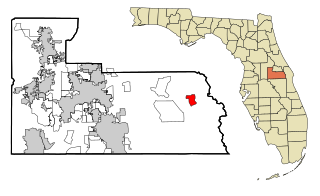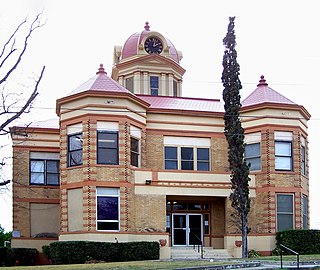See also
- Chris Kimball's website on Second Seminole Indian War ~down 7-17-2014
- Fort Maitland's history from official city website Archived 2006-08-15 at the Wayback Machine
Fort Maitland was a military fort built by the United States Army at what is now Maitland, Florida. It was built in November 1838 as a supply depot during the Second Seminole War. The fort was named after Captain W. S. Maitland, who was injured during the Battle of Wahoo Swamp and later killed himself after 9 months of trying to recover from his injuries.

Middleburg is an unincorporated area and census-designated place (CDP) within Clay County in the U.S. state of Florida, located 26 miles (42 km) southwest of downtown Jacksonville and 16 miles (26 km) northwest of Green Cove Springs, the county seat of Clay County. As of the 2020 census, the population of Middleburg was 12,881, down from 13,008 at the 2010 census. It is part of the Jacksonville, Florida Metropolitan Statistical Area.

Christmas is an unincorporated area and census-designated place in Orange County, Florida, United States. It is part of the Orlando–Kissimmee Metropolitan Statistical Area.

Maitland is a suburban city in Orange County, Florida, United States, part of the Greater Orlando area. The population was 19,543 at the 2020 census. The area's history is exhibited at the Maitland Historical Museum; the city also hosts the Maitland Art Center, as well as notable examples of Mayan Revival architecture and Fantasy architecture, the Maitland Telephone Museum, and the William H. Waterhouse House Museum. A SunRail station is located in Maitland on Highway 17–92. The city is named for Fort Maitland.

Sanford is a city and the county seat of Seminole County, Florida. It is located in Central Florida and its population was 61,051 as of the 2020 census. It is part of the Orlando–Kissimmee–Sanford Metropolitan Statistical Area.

Brackettville is a city in Kinney County, Texas, United States. The population was 1,341 at the 2020 census, down from 1,688 at the 2010 census. It is the county seat of Kinney County.

Fort McCoy is an unincorporated community in Marion County, Florida, United States. It is situated northeast of Ocala and lies between the towns of Sparr and Eureka on County Road 316 and is directly north of Silver Springs on County Road 315. The community is part of the Ocala Metropolitan Statistical Area.

Fort Brooke was a historical military post established at the mouth of the Hillsborough River in present-day Tampa, Florida in 1824. Its original purpose was to serve as a check on and trading post for the native Seminoles who had been confined to an interior reservation by the Treaty of Moultrie Creek (1823), and it served as a military headquarters and port during the Second Seminole War (1835–1842). The village of Tampa developed just north of the fort during this period, and the area was the site of a minor raid and skirmish during the American Civil War. The obsolete outpost was sparsely garrisoned after the war, and it was decommissioned in 1883 just before Tampa began a period of rapid growth, opening the land for development.

Florida's 7th congressional district is a congressional district in the north central portion of the U.S. state of Florida.

Deer Park is an unincorporated community in Osceola County, Florida, United States. It is located off US 192, south of the intersection with County Road 419. The community is part of the Orlando–Kissimmee Metropolitan Statistical Area. It is the location of the Kempfer Cattle ranch, Deseret Ranches of the Church of Jesus Christ of Latter-day Saints, and the Deer Park Forestry Site of the Florida Department of Agriculture and Consumer Services.

Fort King was a United States military fort in north central Florida, near what later developed as the city of Ocala. It was named after U.S. Army Colonel William King, commander of the 4th Infantry Regiment and the first governor of the provisional West Florida region.

The Seminole Soccer Complex is the on-campus soccer stadium at Florida State University in Tallahassee, Florida.

Fort Christmas was built in present-day Christmas, Florida during the Second Seminole War. Construction began on December 25, 1837, with the arrival of 2,000 U.S. Army soldiers and Alabama volunteers.
WYZB is a radio station serving the Fort Walton Beach, Florida area with a country music format. This station is under ownership of Cumulus Media.
Fort Fraser was a United States Army fortification constructed in November 1837 between the modern cities of Lakeland and Bartow in Polk County, Florida. The fort's name was inspired by Upton S. Fraser, a captain in the U.S. Army who was killed by Seminole Indians in the March to Fort King on December 28, 1835. Colonel Zachary Taylor, who later became the president of the United States, served at Fort Fraser as commander of two companies of the 1st U.S. Infantry. The fort was abandoned by the Army in May 1838, only to be informally used later as a shelter during the American Civil War and Third Seminole War.

Fort Ogden is an unincorporated community in DeSoto County, Florida, United States, located approximately 10 miles (16 km) southwest of the city of Arcadia. U.S. Route 17 and the Fort Myers Division of the Seminole Gulf Railway pass through the community, and break away from each other.
Fort Mudge is an unincorporated community in Brantley County in the U.S. state of Georgia.

The Concord Cemetery is a cemetery in Casselberry, Florida, where Seminole Indians, pioneers, and veterans are buried.

Fort Basinger is an unincorporated town in Highlands County, Florida that arose around the Second and Third Seminole Wars fortification: Fort Basinger. The fort was situated 10 miles (16 km) north-west of Okeechobee. Just north of Fort Basinger is Lorida, and just above that is Sebring.

Fort Basinger's original site is located approximately 35 miles (56 km) west of Fort Pierce, Florida, along U. S. Highway 98 in Highlands County, Florida. It was a stockaded fortification with two blockhouses that was built in 1837 by the United States Army. It was one of the military outposts created during the Second Seminole War to assist Colonel Zachary Taylor's troops to confront and capture Seminole Indians and their allies in the central part of the Florida Territory in the Lake Okeechobee region. The Seminole Indians and their allies were resisting forced removal to federal territory west of the Mississippi River as directed by the Indian Removal Act.